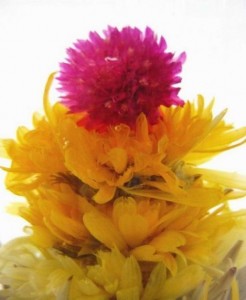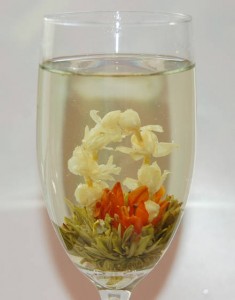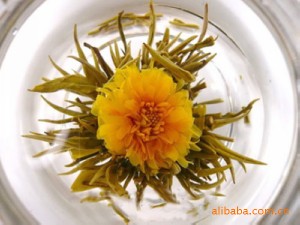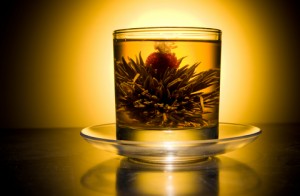 I have just received my stash of blooming tea (also known as flowering tea) and I’m thrilled! There are ten different varieties, some with a green tea base but most with a white tea base. They’re beautiful.
I have just received my stash of blooming tea (also known as flowering tea) and I’m thrilled! There are ten different varieties, some with a green tea base but most with a white tea base. They’re beautiful.
You can see them all here.
They are not only a very pleasant tea drink but also a real attention getter when entertaining. Just stick one in a glass teapot, pour on hot water and watch your guests become enthralled at the display. Honestly, even if you don’t drink the tea, the sight of the flower unfurling will be enough to wow most guests. Every one is hand made and each has its own personality. It takes between 5 to 10 minutes for one to totally unfurl.
If you are a tea lover, my suggestion is to let the tea make its presence known, let everyone have a sip of tea and then unveil your ‘best tea’. For example, you could say, “Oh, wasn’t that great. How about tasting one of my premium white or green or oolong teas?” Then serve your best organic loose leaf tea. A winner. I’m sure.
If you have die-hard black tea drinkers (think Lipton and the sort) you can bring out your premium Red Jade tea and let everyone sample it. I have never added the ol’ “milk and sugar” to it, but I am confident that it would live up to the ol’ cup of Lipton 🙂
Honestly, tea is like wine. Once you have had a good one you will scorn everything else.
Aside from the fact that organic loose leaf teas actually do taste great, they are also very healthy for you. Think of these teas like coffee. Once everyone just drank instant (yuk). Now people buy coffee makers — even drip coffee makers, and enjoy a decent cup of coffee. Tea is the same. Introduce your friends to loose leaf tea and they will be hooked. Nothing quite tastes as good once you have had a decent, freshly brewed loose leaf tea. You can choose: green tea (with its earthy flavor), black tea (which tastes better than any teabag, oolong tea (same health benefits as green tea but a little less organic tasting), or white tea (served to Chinese royalty ONLY for many years.)
Do They Always Work As Expected?
And, back to blooming teas. Not only are they a delight to drink but they are fascinating to watch. Just think, each flowering tea is hand-made. Most work as they should and (the first disclaimer along these lines I think) you do have the occasional dud. Yup, just like fire-crackers. Sometimes you will drop your tea ball into the boiling water and only half of it will unfurl. OK, so the fire-cracker doesn’t go off–but the duds are VERY few and far between. We had one on the weekend; it didn’t live up to our expectations. Having said that, it is the only one so far (of many) that has not performed as well as we had hoped. That is probably why we sell 5 in each pack. All 5 should work as planned. If one doesn’t, send me a video of your fail and I will replace your tea x 2.
Blooming teas are exquisite. They are attention getters. They are hand-made, each one. They are a work of art.






